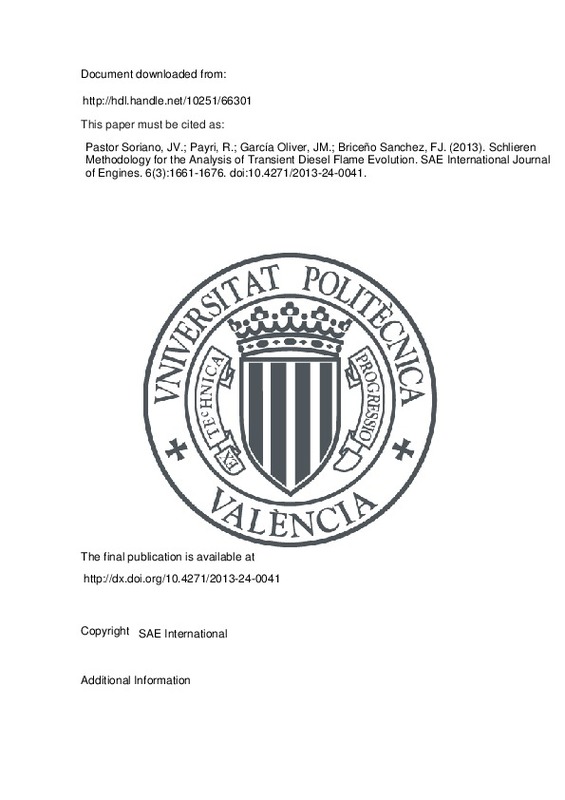JavaScript is disabled for your browser. Some features of this site may not work without it.
Buscar en RiuNet
Listar
Mi cuenta
Estadísticas
Ayuda RiuNet
Admin. UPV
Schlieren Methodology for the Analysis of Transient Diesel Flame Evolution
Mostrar el registro sencillo del ítem
Ficheros en el ítem
| dc.contributor.author | Pastor Soriano, José Vicente
|
es_ES |
| dc.contributor.author | Payri, Raul
|
es_ES |
| dc.contributor.author | García Oliver, José María
|
es_ES |
| dc.contributor.author | Briceño Sánchez, Francisco Javier
|
es_ES |
| dc.date.accessioned | 2016-06-22T10:26:24Z | |
| dc.date.available | 2016-06-22T10:26:24Z | |
| dc.date.issued | 2013-09 | |
| dc.identifier.issn | 1946-3944 | |
| dc.identifier.uri | http://hdl.handle.net/10251/66301 | |
| dc.description.abstract | [EN] Schlieren/shadowgraphy has been adopted in the combustion research as a standard technique for tip penetration analysis of sprays under diesel-like engine conditions. When dealing with schlieren images of reacting sprays, the combustion process and the subsequent light emission from the soot within the flame have revealed both limitations as well as considerations that deserve further investigation. Seeking for answers to such concerns, the current work reports an experimental study with this imaging technique where, besides spatial filtering at the Fourier plane, both short exposure time and chromatic filtering were performed to improve the resulting schlieren image, as well as the reliability of the subsequent tip penetration measurement. The proposed methodology has reduced uncertainties caused by artificial pixel saturation (blooming). Additionally, an algorithm to calculate Lift-off length from schlieren images has been developed and compared to the more conventional OH* imaging technique. By means of the improved setup, the analysis of transient diesel flame has been performed throughout the ignition and early combustion phases. When compared to a non-reacting vaporizing spray, the temporal evolution of the reacting case departs from the inert one at the start of combustion, when expansion in both axial (i.e. spray tip increase) and radial direction are observed. After that, the tip penetration progressively decreases on a clear transient period where the flow tries to re-organize itself in response to the induced reaction zone. Eventually, the spray undergoes an acceleration period where the reacting spray tip progresses above the non-reacting one. A parametric study has been conducted for three injection pressure levels to investigate the influence of this parameter upon transient flame evolution. | es_ES |
| dc.description.sponsorship | This work was partially funded by the Spanish Ministry of Education and Science through the “LES METHODS FOR THE SIMULATION OF MULTIPHASE SPRAYS” project (ENE2010-18542). Mr. Francisco J. Briceño wishes to acknowledge financial support through a PhD studies grant (AP2008-02231) also sponsored by the Spanish Ministry of Education and Science | |
| dc.language | Inglés | es_ES |
| dc.publisher | SAE International | es_ES |
| dc.relation.ispartof | SAE International Journal of Engines | es_ES |
| dc.rights | Reserva de todos los derechos | es_ES |
| dc.subject.classification | MAQUINAS Y MOTORES TERMICOS | es_ES |
| dc.title | Schlieren Methodology for the Analysis of Transient Diesel Flame Evolution | es_ES |
| dc.type | Artículo | es_ES |
| dc.identifier.doi | 10.4271/2013-24-0041 | |
| dc.relation.projectID | info:eu-repo/grantAgreement/MICINN//ENE2010-18542/ES/METODOS LES PARA LA SIMULACION DE CHORROS MULTIFASICOS/ | es_ES |
| dc.relation.projectID | info:eu-repo/grantAgreement/MICINN//AP2008-02231/ES/AP2008-02231/ | es_ES |
| dc.rights.accessRights | Abierto | es_ES |
| dc.contributor.affiliation | Universitat Politècnica de València. Departamento de Máquinas y Motores Térmicos - Departament de Màquines i Motors Tèrmics | es_ES |
| dc.description.bibliographicCitation | Pastor Soriano, JV.; Payri, R.; García Oliver, JM.; Briceño Sánchez, FJ. (2013). Schlieren Methodology for the Analysis of Transient Diesel Flame Evolution. SAE International Journal of Engines. 6(3):1661-1676. https://doi.org/10.4271/2013-24-0041 | es_ES |
| dc.description.accrualMethod | S | es_ES |
| dc.relation.publisherversion | http://dx.doi.org/10.4271/2013-24-0041 | es_ES |
| dc.description.upvformatpinicio | 1661 | es_ES |
| dc.description.upvformatpfin | 1676 | es_ES |
| dc.type.version | info:eu-repo/semantics/publishedVersion | es_ES |
| dc.description.volume | 6 | es_ES |
| dc.description.issue | 3 | es_ES |
| dc.relation.senia | 253401 | es_ES |
| dc.contributor.funder | Ministerio de Ciencia e Innovación |







![[Cerrado]](/themes/UPV/images/candado.png)

